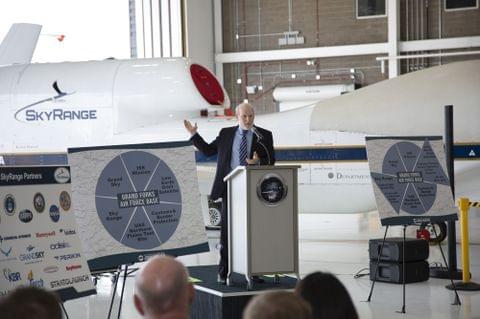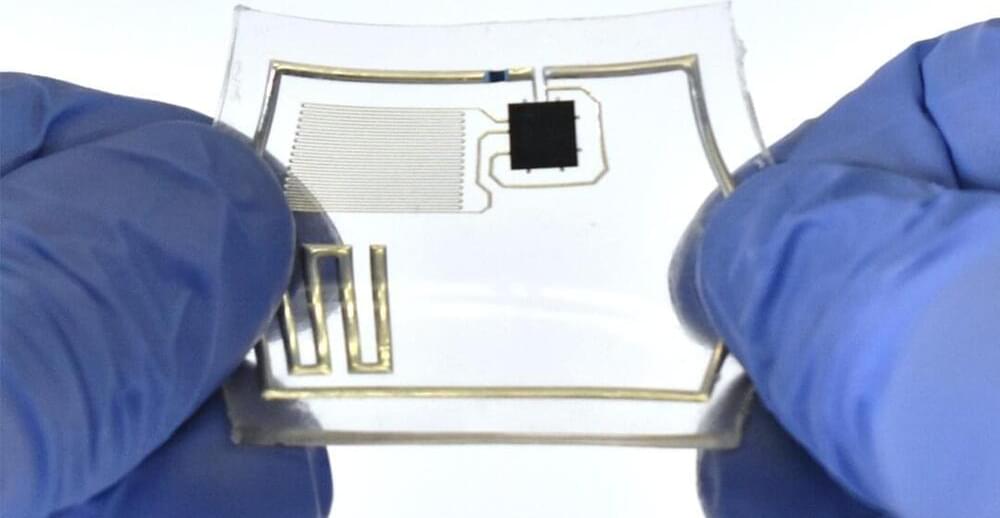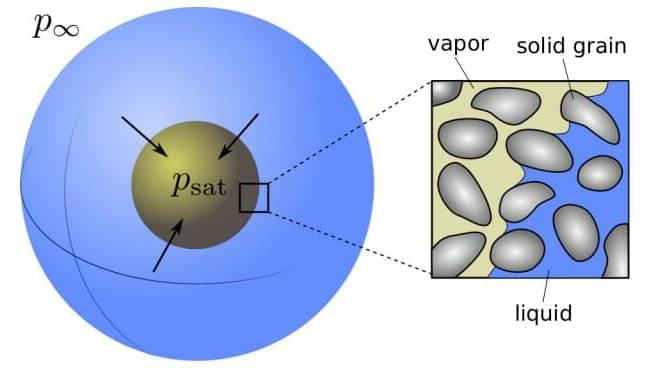It’s the officially spooky season in space.
In its newest image, the Webb Space Telescope teams up with Hubble to study how stars form in nearby galaxies.


No more dark side of the Moon?
An international research team headed by ETH Zurich has investigated the permanently shadowed regions of the Moon with the use of artificial intelligence. Future lunar missions will be able to find acceptable spots thanks to the knowledge they have gained about the region’s physical properties.
The research was published in Geophysical Research Letters on August 26.
We produce the first high-signal-to-noise ratio and-resolution orbital images over 44 shadowed regions within the Artemis exploration zone using an AI tool.

It will be reconfigured to meet testing needs.
The giant drone, RQ-4 RangeHawk, will soon be used to support the development of hypersonic missiles in the U.S., its manufacturer, Northrop Grumman, said in a press release.
Hypersonic missiles are the newest frontier in the weapons race, with countries like Russia and North Korea laying claims to have successfully demonstrated this technology. The U.S. hypersonic missile program has faced a few hiccups with repetitive test failures. Last month, the U.S. Air Force confirmed that its Air-launched Rapid Response Weapon (ARRW) had been successfully tested, almost after a year after similar claims from Russia.
GRAND FORKS, N.D. – Aug. 24, 2022 – Northrop Grumman Corporation’s (NYSE: NOC) RQ-4 RangeHawk is poised to support the SkyRange program’s U.S. hypersonic missile flight tests from its Grand Sky facility near Grand Forks, North Dakota. SkyRange is the Department of Defense Test Resource Management Center’s (TRMC) unmanned high-altitude, long-endurance, responsive mobile flight test system.
In support of the SkyRange initiative, Block 20 and 30 RQ-4B Global Hawk aircraft are being transferred to TRMC to be reconfigured into RangeHawks. The conversion will integrate advanced payloads to equip the aircraft with the capability to support the testing of hypersonic vehicles and other long-range weapons. RangeHawks provide over-the-horizon altitude, endurance and flexibility, which are critical for collecting telemetry and other data to monitor the vehicle during flight tests. Increasing the capacity of hypersonic vehicle testing furthers research and development necessary to remain competitive in the global landscape.
“Our RQ-4 RangeHawks will support the emerging class of hypersonic weapons and provide a combination of range, endurance and payload capacity,” said Jane Bishop, vice president and general manager, global surveillance, Northrop Grumman. “These aircraft will continue their role in vital national security missions while enabling us to bring premier aircraft design, modification, operations and sustainment work to the Grand Forks community.”

The company achieved the leap from 14-nm to 7-nm without the most advanced equipment due to U.S. curbs.
U.S. sanctions intended to halt the rise of China’s largest chipmaker, Semiconductor Manufacturing International Corp (SMIC), didn’t stand a chance against the company’s technological progress.
SMIC took two years to achieve the leap from 14-nm to 7-nm, faster than TSMC and Samsung, TechInsights said.

In the past two years, it has only been at sea for 90 days.
The Royal Navy’s largest aircraft carrier, HMS Prince of Wales, has broken down near its base of Portsmouth — on day two of its mission to the U.S., Business Insider.
The centerpiece of modern combat fleets, an aircraft carrier is a warship that is equipped with a full-length flight deck and facilities for deploying and recovering aircraft at sea. Since the carrier sails in international waters, it does not interfere with the sovereignty of nations, while also serving as an airbase for staging aerial operations, when required, with rapid response times.
The UK’s newest and biggest aircraft carrier broke down on the second day of what was meant to be a months-long deployment to the US.
HMS Prince of Wales, a £3 billion ($3.5 billion), suffered a mechanical issue Sunday and remains near its base of Portsmouth on the UK’s southern coast.

The world needs a bridge to the renewable energy future.
The world needs more oil and gas to deal with the energy shortages it is currently facing, Tesla CEO Elon Musk said at an energy conference in Norway on Monday, Bloomberg.
The comment might seem strange coming from a person who sells electric vehicles, battery packs, and solar roofing products. However, this isn’t the first time Elon Musk has made such a comment.
The world needs more oil and gas now to deal with an energy shortage while pushing to transition to renewable supplies, Tesla Inc. Chief Executive Officer Elon Musk said.

Summary: The brains of people playing online video games synchronize, even when there is a physical distance between the players.
Source: University of Helsinki.
Online gaming and other types of online social interaction have become increasingly popular during the pandemic, and increased remote working and investments in social technology will likely see this trend continue.

Carnegie Mellon mechanical engineering researchers have developed a new scalable and reproducible manufacturing technique that could accelerate the mainstream adoption and commercialization of soft and stretchable electronics.
The next generation of robotic technology will produce soft machines and robots that are safe and comfortable for direct physical interaction with humans and for use in fragile environments. Unlike rigid electronics, soft and stretchable electronics can be used to create wearable technologies and implantable electronics where safe physical contact with biological tissue and other delicate materials is essential.
Soft robots that safely handle delicate fruits and vegetables can improve food safety by preventing cross-contamination. Robots made from soft materials can brave the unexplored depths of the sea to collect delicate marine specimens. And the many biomedical applications for soft robots include wearable and assistive devices, prostheses, soft tools for surgery, drug delivery devices, and artificial organ function.

A tiny bubble popping within a liquid seems more fanciful than traumatic. But millions of popping vapor bubbles can cause significant damage to rigid structures like boat propellers or bridge supports. Can you imagine the damage such bubbles could do to soft human tissues like the brain? During head impacts and concussions, vapor bubbles form and violently collapse, creating damage to human tissue. Purdue University fluid mechanics researchers are now one step closer to understanding these phenomena.
“When a bubble collapses inside a liquid, it generates pressure shock waves,” said Hector Gomez, professor of mechanical engineering and principal investigator. “The process of forming a vapor cavity and its collapse is what we call cavitation.”
“Cavitation has been studied since the 1800s,” said Pavlos Vlachos, the St. Vincent Health Professor of Healthcare Engineering and director of the Regenstrief Center for Healthcare Engineering. “It’s a very complex field of study because it involves non-equilibrium thermodynamics, continuum mechanics, and many other factors on a scale of micrometers and microseconds. After hundreds of years of research, we are only just now starting to understand these phenomena.”
There are a number of constants in the basic laws of physics and initial conditions of the universe that are such that, for life to be possible, the values of those constants needed to fall in an exceedingly narrow range. Many scientists and philosophers think there must be an explanation of why, of all the values they might have had, these constants have precisely the values needed in order for life to be possible. There are deep difficulties with both of the standard explanations of this ‘fine-tuning’ of the laws of nature: theism and the multiverse hypothesis. I will argue that if one adopts a certain form of panpsychism, one can explain the fine-tuning in terms of the mental capacities of the universe, and that this constitutes a significantly less problematic and significantly more parsimonious explanation of the fine-tuning.
Philip Goff is Associate Professor in philosophy at the Central European University in Budapest (a unique and wonderful institution). His main research interest is consciousness, although he also has a sideline in political philosophy (taxation, globalisation, social justice). He recently finished his first book, Consciousness and Fundamental Reality (published with Oxford University Press August 2017), which argues against materialism and defends panpsychism. He is now working on a book on these themes aimed at a general audience. He has written for The Guardian and Philosophy Now, and writes a blog at www.conscienceandconsciousness.com. www.philipgoffphilosophy.com @philip_goff